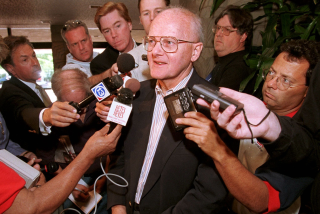Selecting a Supplier to Meet Your Demands
- Share via
“Where’s the money in Web publishing?” participants at the ever-increasing number of Web conventions and conferences ask one another.
Here’s one answer: It’s in the vast range of tools and services that Web publishers need to create their sites, keep them current, and attract and measure viewers. This supply industry is booming, and since Web publishers must constantly renew their investments in hardware, software and content if they want to stay current with fast-changing technology, it probably won’t be slowing down any time soon.
Publishing on the Web requires making deals with many different types of suppliers. What are some of the questions you might ask? There are too many variables to list specific companies or services, but here’s a guide to the thinking involved.
*
Establishing a site: The first thing to consider is how to get the computerized word from your place out to the Internet. There are loads of Internet service providers that will host Web sites and provide all manner of specialized services. If you have the skills, you can do it yourself: lease phone lines from a telecommunications company, buy computer equipment such as servers and routers, and choose software that will make the site run and keep it free of hackers.
If you’re contracting for most of the services, there are many levels of excellence and many different prices. What will distinguish the more sophisticated firms are services like maintaining the site 24 hours a day, alerting technical people about interruptions, tracking site usage and issuing timely reports. Fewer services or less coverage means less money.
Another distinguishing element may be the ability to integrate the Internet services with a prospective Web publisher’s existing computer systems. These costs can sometimes be huge.
A subset of ISPs and communications companies are Web design firms. Design issues are far more complex than simple look and feel. Do you want to limit the amount of graphics to assure fast performance? Do you want to use the latest, faddish technologies that might leave portions of the audience behind? There are as many business issues in design as there are presentation issues.
A key issue is determining just how much of a commitment your company wants to make. Each of these services can run into thousands or tens of thousands of dollars of investment. And even if you buy these services rather than build them in-house, you’ll still need to understand the technical alternatives, know the marketplace and manage the projects involved.
*
Chat, bulletin boards and interactivity: Publishers now have more and more options for specialized software and services that add interactive features to a Web site. Most Internet designers and marketers these days say it is not enough simply to publish; your Web site must offer visitors the chance to talk back, play games and personalize the site.
Prices can run from a few hundred dollars for off-the-shelf software to many thousands of dollars for features that allow for site customization and management.
A crucial first question is whether people truly want to talk about what you are offering. With so many using the standard chat of America Online, for example, how much more time or attention or interest will there be in a discussion of your product line?
Do you want someone else running your forums, or do you really want just the software? Are there limits for the kind of forums that you will allow to appear on the site? Will you have the time and the staff to monitor computerized conversations? Will you pay someone to monitor conversations throughout the week, or will you deal with the consequences of an unmonitored chat room?
*
Mapping: This is a capability that is proving to be very popular, especially among information companies. Companies like Vicinity Corp. (https://www.vicinity.com) or MapBlast (https://www.mapblast.com) offer services that help visitors locate geographic addresses on the fly.
These are extremely well-done, useful services, and they seem to contain the seeds for commercial application. They are easy to use, generally requiring only the typing in of an address, with the reader deciding how much detail is needed in the map.
The idea is to use such capability to locate other information that might be relevant to publishers’ information. A movie site, for example, might have a map locating movie theaters and might also be able to list the nearby restaurants.
That kind of use of technology is what drives a commercial application.
*
Auditing and counting: There are now a number of services and software programs that can count ad clicks, “hits” to the site, page impressions, visits to sub-categories and the source of the visits.
Several companies, including I-Pro, NetCount and Audit Bureau of Verification Services Inc., now offer such services, but each seems to measure elements in slightly different ways. One company may simply verify what your logs show, and another runs software that accumulates independent usage reports. Making a decision among these companies requires that you understand exactly what you want to know and why, or what your customers need to know.
Take caution, too, in that some of the auditing company software work only on certain platforms. If auditing is important to your effort, you may need to ensure that the company hosting your Web site understands that issue as well.
*
Schwadron is deputy managing editor of The Times and oversees latimes.com, The Times’ Web site. He can be reached via e-mail at terry.schwadron@latimes.com





